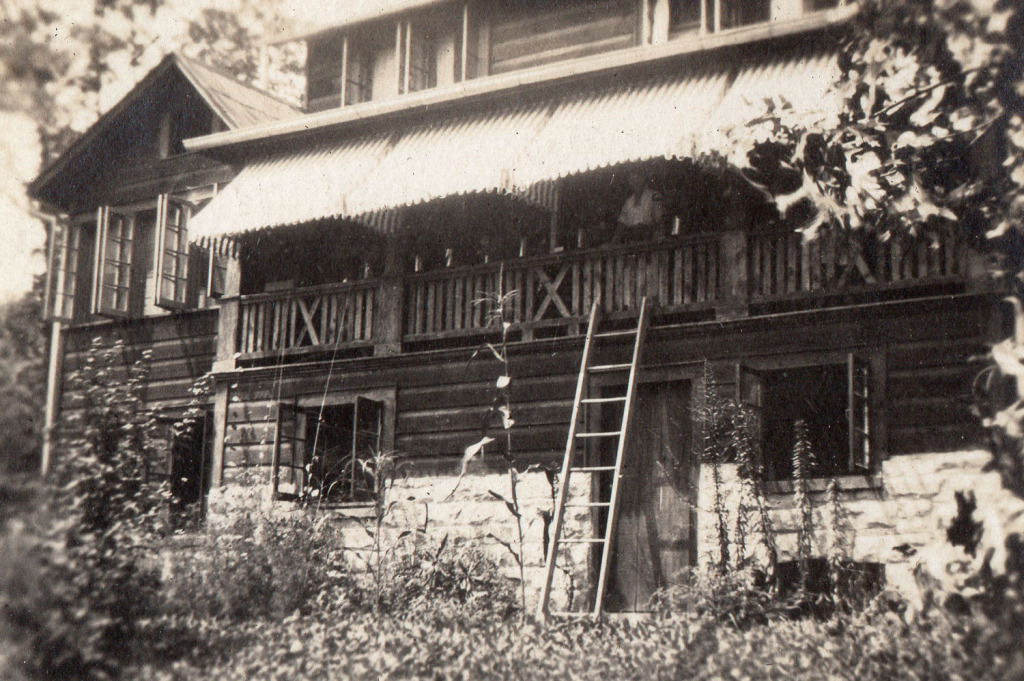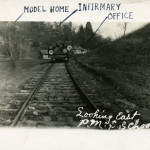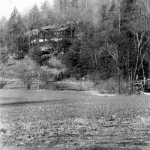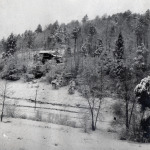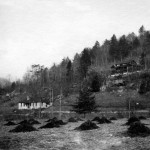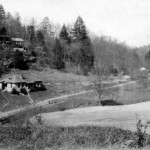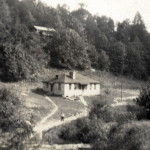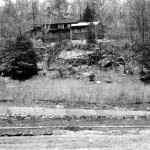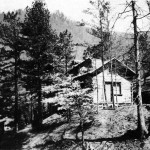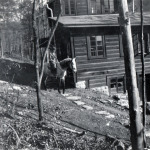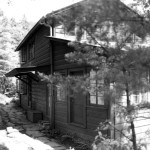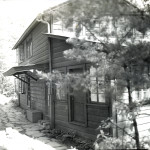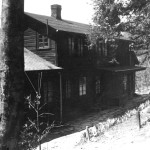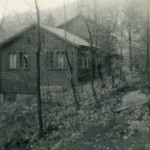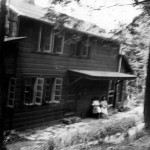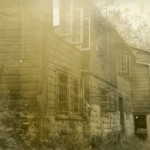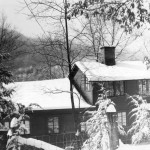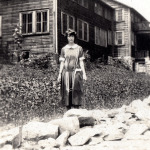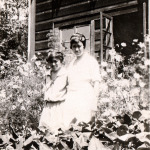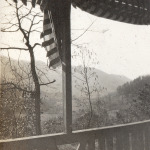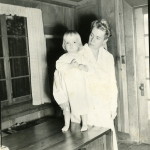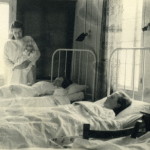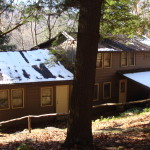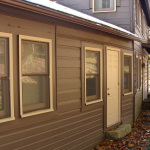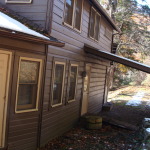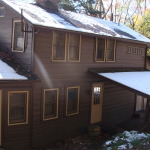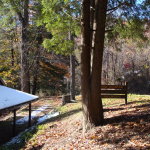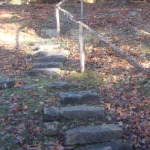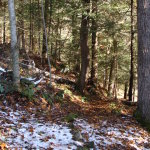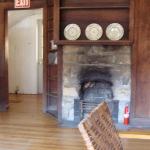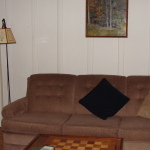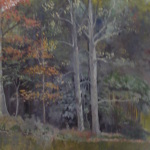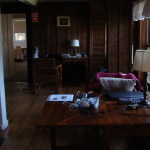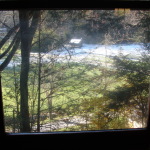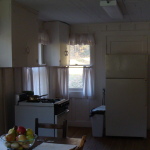Pine Mountain Settlement School
Series 10: BUILT ENVIRONMENT
Infirmary (Hill House), 1918-present
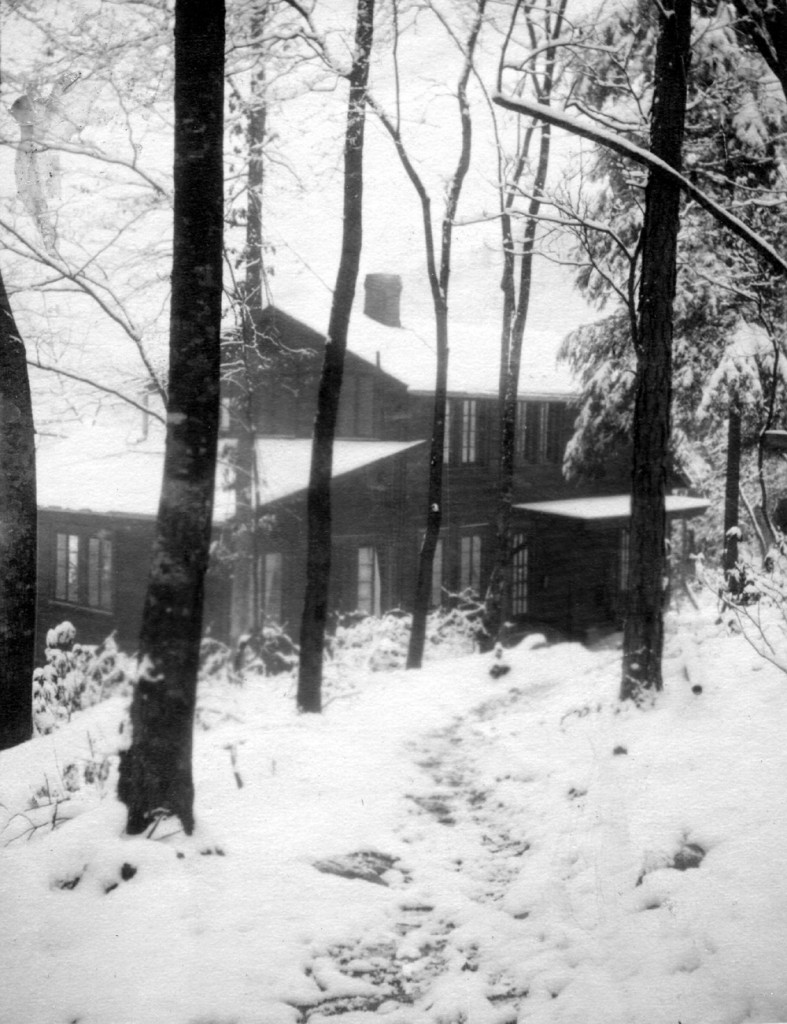
Infirmary (aka Hill House), showing a snowy path from the road to the front door. [II_7_practice_house_312.jpg]
INFIRMARY (Hill House)
Infirmary (Hill House), 1918-present
Valuation in 1926 – $6,148
TAGS: Infirmary, Hill House, health care, health education, hospital, donors, nurses, doctors, Kentucky Sanitary Closets, Old Log house, smallpox, vaccinations, railroad passes, clinics, Boys House, dentists, quarantine, epidemics, surgeries, extension centers, Doctor’s Cabin, community, West Wind, Spanish influenza
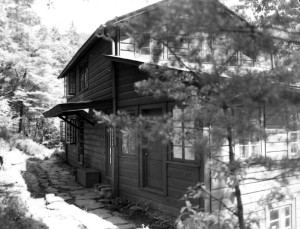
Infirmary (Hill House). Raking view of the entrance.[lI_7_infirmary_309.jpg
The Infirmary (later known as “Hill House”) was the early center of health care and health education at the Pine Mountain Settlement School. Constructed in 1918 to serve as a central hospital for the School and the outlying areas, the Infirmary was built with memorial gifts from Mrs. A.F(?), Mr. J.G. Seaman, and Mr. W.G. Sewall. Its location is on the south flank of the mountain and commands a long view of the campus below.
It is a two-story building on the north side and a three-story structure on the south side. The construction is board and batten with a sharply sloped gabled roof. The building’s designer is uncertain, though it is most surely Mary Rockwell Hook. The current kitchen area appears to have originally sported a gable roof and its awning shaded a long deck that stretched across the south side of the building. The deck has been removed and the windows replaced throughout.
Infirmary: HISTORY OF HEALTH CARE AT PMSS 1914-1928
The following is a partial transcription of a narrative by Evelyn K. Wells from her unpublished early history of the school at Pine Mountain Settlement School. Wells outlines the history of health care at the School from 1914 through 1928:
From the very beginning, emphasis was laid upon constructive health work of all kinds. One of the members of the first School family was Miss Clara Davis, a nurse, whose work was of course mostly in the community, visiting district schools and homes. She laid a foundation of friendly relations with the neighborhood because of her ministrations along lines that everybody could understand. She began the long campaign against such problems as hookworm, trachoma, and flies and agitated for sanitary closets and quarantine against infectious diseases, to say nothing of preaching against the physical inroads of alcohol and cigarettes.
During the summers of 1914 and 1915 Dr. Blanche Epler ** of Kalamazoo, Michigan, spent some weeks at the School as a volunteer worker, helping work out the initial problems of sanitation in the School and the care of the children’s health. Her vigorous personality did much to define the health principles of the School from the start. At this time the Kentucky Sanitary Closet was adopted as being the most practical for the School’s needs. Later experience has not wholly borne out the wisdom of this choice.
In the fall of 1915, when Far House was ready to live in, Miss de Long took her children and left Old Log House. From then on, until the Infirmary was finished in 1920, Old Log served as the only hospital accommodation the School possessed. Old Log’s northern room was used as the Office till the summer of 1918 when the first Burkham Schoolhouse was ready. The nurse or doctor used the southern room, which was also the sitting room for the family; the dogtrot and loft were its sleeping quarters. The medical staff therefore had to take care of its patients in their own beds, but dressings and examinations went on at Old Log. In the winter there were all sorts of difficulties, extreme cold, darkness and dampness being the worst to combat. Whenever activities could be transferred to the porch, the nurse felt a tremendous relief.
Miss Christie, the nurse in the fall of 1915, was presented with the problem of dealing with a small-pox epidemic which broke out in the neighborhood. She took care of Aunt Sal and Columbus Creech, who were housed during most of the winter’s bad weather. The School had to shift for itself since the nurse was quarantined with the Creeches, and Miss Evelyn K. Wells and others vaccinated about forty children and workmen. Vaccination was a new thing in those days, and the bad ‘takes’* were accepted sometimes with the bad grace of limited understanding. As, for instance, when Oscar Whited, a young man of twenty-two or so, ”one of our students, couldn’t bear his sore arm, left his job of breaking flax and went home.” The young worker who had vaccinated him wondered anxiously how he would take his revenge.
From the spring of 1916 to 1918, when she left for work overseas [to Armenia ?], Dr. Abby H. Little worked “under the picturesque difficulties” of life at Old Log House and in the neighborhood. During her stay the School family grew from thirty-five to seventy. Then followed a succession of nurses: Miss Euphemia Larrabee of Boston, Miss Margaret Walker, a Canadian, Mrs. Helen Briscoe, here for a few weeks, and Miss Frances Lavender, who was here 1918-1919.
At the close of Miss Walker‘s stay, Uncle William Creech was in his last illness, and she took entire care of him, escorting him to Louisville and staying there till the end of his life. To Miss Lavender fell the task of caring for the injured children and the shaken School after the Schoolhouse burned in January 1919. The fire destroyed much of our medical equipment, as a small clinic room had been maintained in the Schoolhouse; and afterwards the nurse was forced to return to the hospital in Old Log House until the Infirmary was ready in 1918 [?].
Miss Esther Sandstrom and Miss Charlotte Roderick were the last two nurses to work under the old conditions, From 1920 on, the constructive health program moved steadily, with establishment of clinics, building up of underweight children, steady treatment of hookworm, and checking epidemics with increasing ease. The notes of workers’ meetings at this time are filled with health discussions, regulations going into effect, the standardizing of the care of the children in a hundred ways affecting their health. Such obvious rules as [instructing] that the children must be examined by the nurse before admission to the School, that nobody but the nurse must prescribe for ailing children, that the nurse had regular hours daily for visits from the children, all came to effective enforcement at this time, after years of irregularity and struggle.
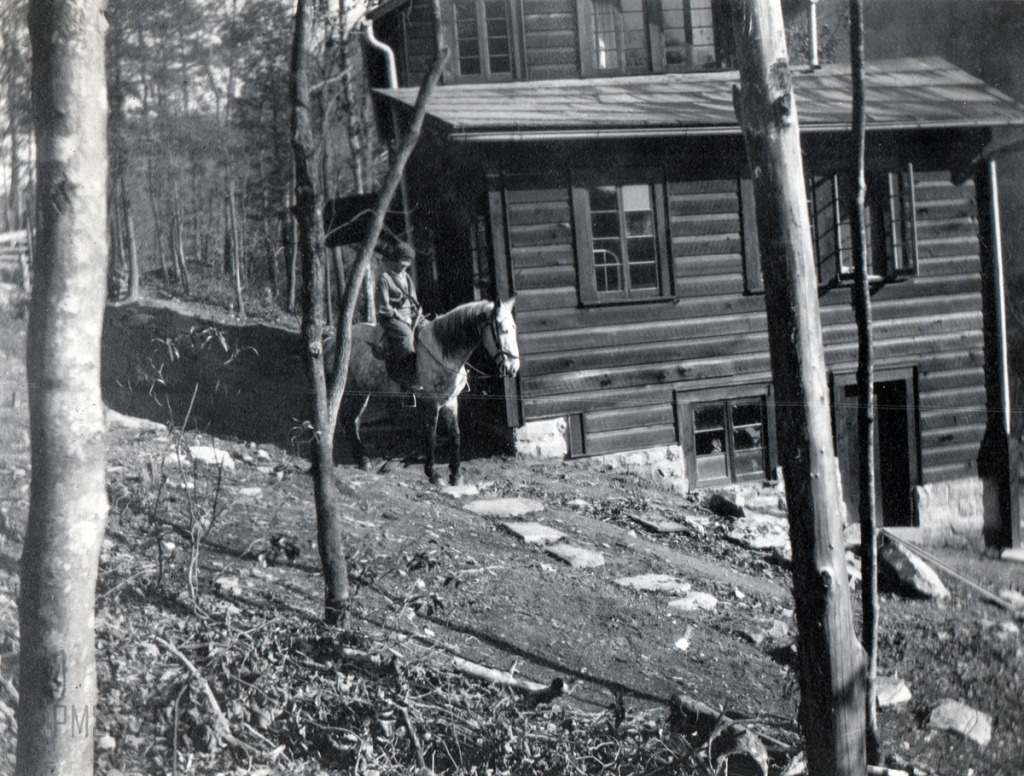
Maya Sudo Album: View of the west flank of PMSS Infirmary with horseback rider (Maya Sudo, nurse). [sudo_album_004.jpg]
The Infirmary made much possible that [which] had to wait till we had such a building. That sunny, comfortable, adequate house made the greatest difference in the life of the School. Miss Maya Sudo, the Japanese nurse who was here from 1921 to 1924, gave it many of its lasting beautiful touches in the garden and grounds as well as starting it off with its exquisite routine inside.
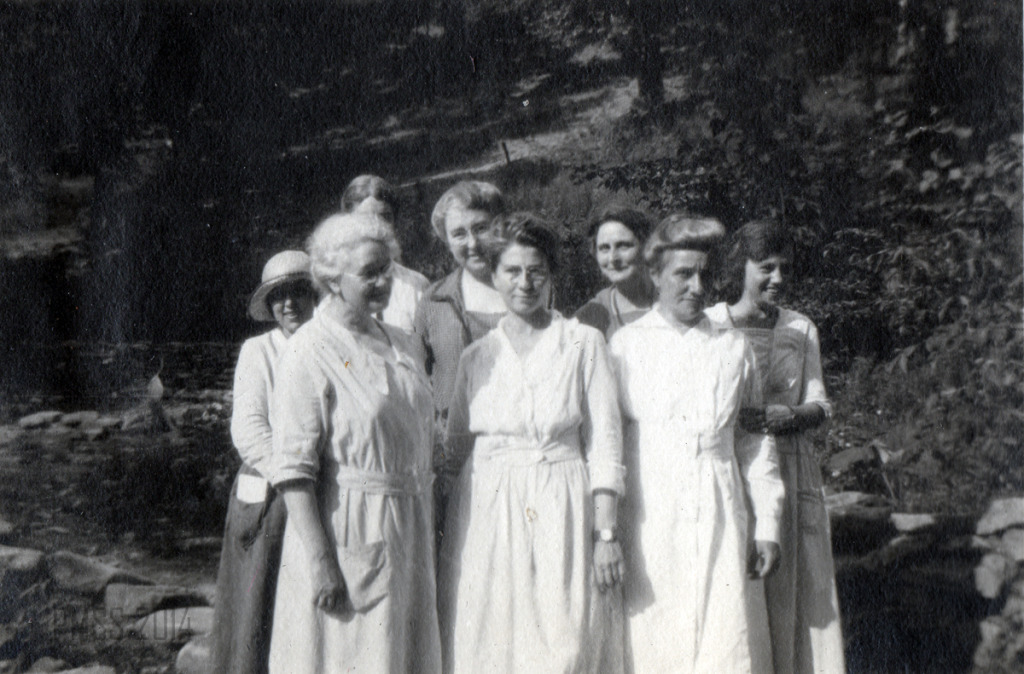
Maya Sudo Album: Harriet Butler with group of nurses and other PMSS medical staff, c. 1921. (Maya Sudo is to the far left. [sudo_album_ 024b.jpg]
Miss Eva Heney, who came in 1924 and was here until the winter of 1927, is responsible for its further steady growth. These two long periods of continuous administration of one policy have been fortunate for us. In the Spring of 1927 and 1928 Miss Betty Key and Miss Marian Purbrick have seen us through many crises. In the winter of 1928 the last ward of the Infirmary was enlarged, and a bathroom was built that included the campus’s first indoor toilet.
**[Dr. Blanche Epler of Kalamazoo, Michigan, later helped to organize the Girl Scouts of Kalamazoo. She practiced in the Hanselman Building in the city and was a well-known figure in the early history of the city.]
Whenever possible, the nurse has had regular classes in nursing and hygiene. She has always been available for calls out into the country, when we did not need her in the School. Miss Heney’s faithful friendship for the Jasper Days at the head of Gabes branch is typical of the help the School has always tried to render. (See spring letter [Dear Friend Letter, 1926.)
A constant stream of children and neighbors has gone down to the hospitals in Louisville, and Lexington for operations and examinations. The Louisville and Nashville Railroad has furnished passes, often issuing one for the nurse or accompanying worker. Clinics at the School have taken care of tonsils and adenoids, eye refractions, dental work. The first clinic was held by the State Board of Health, for hookworm, the first year of the School’s existence. In 1918 a tonsils and adenoids clinic took place at the School and stands out in our minds because of our first experience with a ‘bleeder,” Bonnie Baker. Since then we have always insisted on one of the doctors remaining over with us until all danger of bleeding was over.
In August 1919 Drs. Velch and Grant of Louisville came for dental work. In November 1922 Dr. Stucky of Lexington and Dr. Day of Pittsburgh came for one of the most ambitious clinics we have had. The Boys House was turned into a hospital, and stretched to capacity. In two days the record was:
Examinations 321
Eye Refractions 38
Operations under anesthetic 83
Other operations 35
Dr. Grant came again in 1923, and in 1924, Dr. Day sent down from Pittsburgh Drs. McMonigle and Black. Dentists from Pittsburgh came again in 1925. Mr. Jaggers of Louisville came for two years for eye refractions. And one cannot name the doctors in Louisville who have given free treatment to our children, or the friends there who have looked out for them.
Quarantine of the School in the fall of 1918 prevented a single case of Spanish Influenza from breaking out, though the neighbors, showing a low immunity, were ravaged. This was a most effective lesson to everybody on the value of quarantine. We have not always been as fortunate in keeping out contagious diseases and measles (1920, with Boys House needed to take care of the 40 cases), mumps (worst in 1926, when they overflowed to the Country Cottage) and whooping cough (1924) have been our worst epidemics. There have been two deaths from sickness, among the children of the School. In 1923 Harry Callahan died of spinal meningitis resulting from severe injuries to the head when he was thrown from a moving train, and in 1924 James Gilbert died, also of spinal meningitis.
There has been a steady decrease in colds and minor epidemics as underweight children have been built up by extra milk, rest [and] other special care, which has reacted upon the physical vigor.
The nearest approach to a major operation at Pine Mountain was in 1928 when Dr. Todd came from Lynch and removed liquid from Miss Gallagher’s lungs thereby saving her life in pneumonia. Miss Purbrick and Alice Turner will not soon forget that midnight affair. (In the very real emergencies when we have sent for Dr. Todd, he has never once failed to come to us, crossing the mountain usually after dark, often on foot, and in all weathers.)
The health work of our extension centers is discussed in the section dealing with them. It should be said, however, that the Medical Settlement physician, Dr. Huse from 1920 to 1924, and since then, Dr. Withington, has been in charge of the health policies of the School, the cases of actual sickness, and general direction of the nurse’s work. The doctor has also given the first physical examinations to children entering school.
DR. KENNETH GOULD
Dr. Kenneth N. Gould was hired by Glyn Morris in February 1932 to meet a growing need in the community for a doctor. Morris gave him full privileges to “Sunny Jim,” the horse used by the medical staff to visit in the community. “Sunny Jim” had a long reputation of stopping suddenly if startled by a loud noise. As a mountain horse, “Sunny Jim” had once been caught in a feud and received a bullet through the nape of his neck making him very skittish around gun-fire.
Gould, according to Morris’ autobiography, Less Traveled Roads [p.107] was paid $166.66 per month for his services and lived in the small cabin at the foot of the Infirmary path, sometimes called the “Doctor’s Cabin.” The son of a missionary in India, Gould was also eccentric. According to Morris he enjoyed curds and whey and kept a pet rattlesnake in a cage in his cabin. It was his first post following his graduation from medical school in Louisville and he lasted close to two years. He left in December of 1933.
DR. FRANK W. NEWMAN
Dr. Frank W. Newman, a graduate of the College of Physicians and Surgeons at Columbia University, followed Dr. Gould and brought with him a wife who was trained as a nurse. Elizabeth and Frank had been married only three days before they arrived at the School with the express purpose of gaining experience for an appointment in the foreign missionary work in China. The Newmans left Pine Mountain in 1935 and, in 1936, headed to China. But their timing could not have worse, as the Japanese invaded and the province where they were assigned, Hunan, was particularly devastated. They continued to work in China for about ten years, working in hospitals in various cities, until the establishment of the Communist government made it impossible for them to stay. In 1951 the Newmans and their three children returned to the U.S.
A year later, they were assigned to Cameroon in West Africa, where they successfully established a model clinic and stayed for fifteen years. Morris points out that the Newmans’ work in Cameroon involved establishing a paraprofessional program using locally trained personnel. It was a groundbreaking practice that Morris indicated might have been inspired by the student program at Pine Mountain.
FOUR OTHER DOCTORS
Four more doctors followed Dr. Newman and all were in training for — or had just returned from — foreign mission work and their stays were also short-lived. One of the doctors was Dr. Wilmer S. Lehman.
The Tuckers followed Dr. Lehman. Dr. Emma And Dr. Francis Tucker were forced out of China when the Japanese invaded in 1937. Both doctors are seen in the below image with Grace Feng Liu who came with them from China.
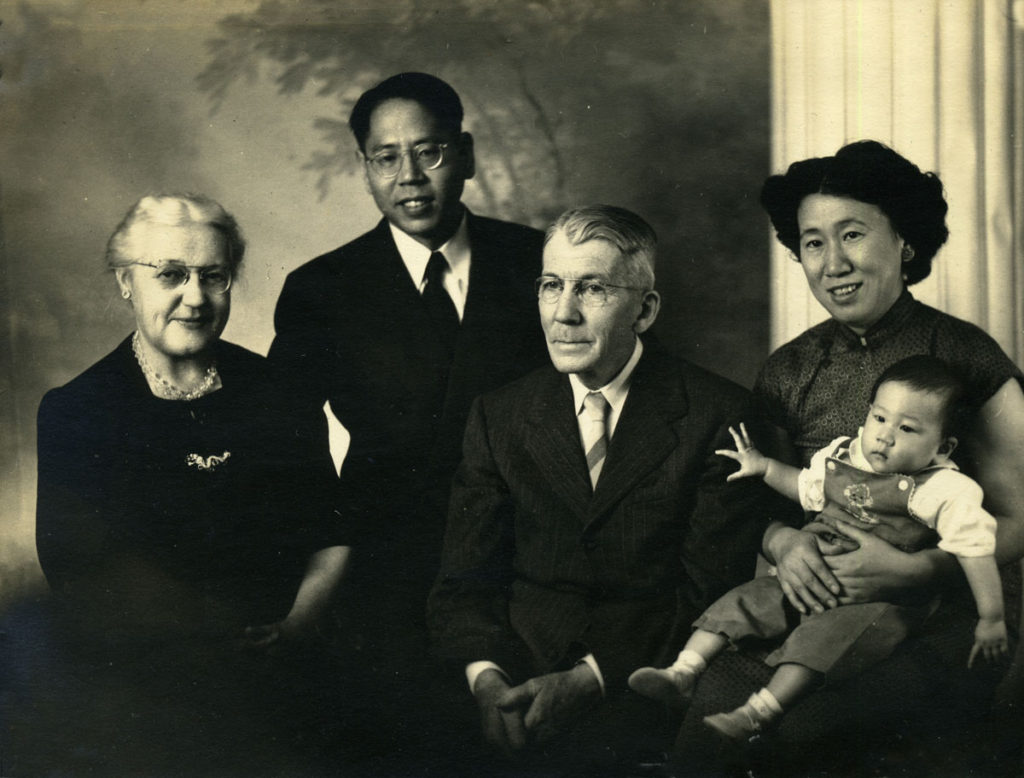
Dr. Emma and Dr. Francis Tucker, Infirmary doctors, with Grace Feng Liu, nurse, and her husband and child. c.1944-45 [rood_030x.jpg]
Infirmary: SERVICE AREA OF INFIRMARY
Other than medical facilities associated with the corporate mining towns in the area, the Infirmary was reportedly the only regional infirmary facility that served the rural populations in a broad swathe of Eastern Kentucky in the 1930s and 1940s. Needs for the clinic were obtained largely through appeals for help from donors. One very generous gift was an X-Ray machine given to the School in 1943 by Miss Elizabeth Kirkland.
Remarkably, the Infirmary was only a ten-bed hospital for the 400-square-mile service area. The service area regularly included the population at the Settlement School, the nearby community of Linefork, and some 250 families in the extended community in all directions.
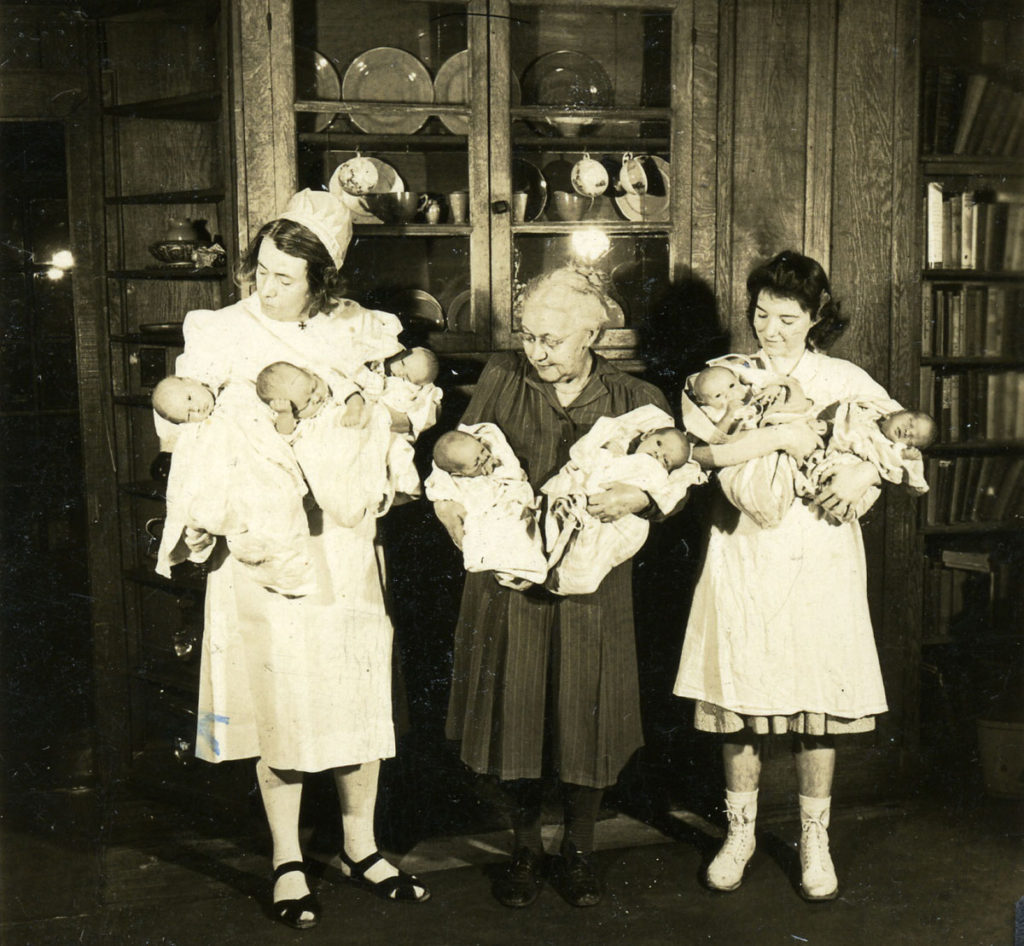
Interior of the Infirmary with Dr. Tucker at center, Nurse Grace Rood to her right, and nurse to her left. Standing in front of the fireplace. [rood_021x.jpg]
To further explore the medical history of programs at the School see:
INFIRMARY
Dr. CLARK BAILEY
Dr. WALLER O. BULLOCK Jr
Dr. KENNETH GOULD
Dr. ELIZABETH HENDERSON
Dr. HOWARD H. INGLING
Dr. FLORENCE HOUGHTON JONES
Dr. WILMER S. LEHMAN
Dr. FRANK W. NEWMAN
Drs. EMMA & FRANCIS TUCKER
DOROTHY LaRUE, Nurse
GRACE FENG LIU, Nurse
FRANCES LAVENDER, Nurse
ELIZABETH NEWMAN, Nurse
GRACE M. ROOD, Nurse
MARGARET WALKER, Nurse
MARGARET FROST TWICHELL, Infirmary Medical Assistant
Dr. LLEWELLA MERROW
Dr. IDA STAPLETON
MEDICAL SETTLEMENT – Big Laurel
Huse, Grace 1918-23 Physician
Little, Abby N. 1916-18 Physician
Withington, Alfreda 1924-28 Physician
Butler, Harriet 1918-23 Nurse
Davis, Clara 1913-15 Nurse
Lavender, Frances 1918-19 Nurse
Medcalf, Anne Ruth 1921-24 Nurse
Palmer, Frances 1920 Nurse
Skidmore, Mrs. Mary 1923 Nurse
Sudo, Maya 1920-21 Nurse
Walker, Margaret 1917-18 Nurse
MEDICAL, HEALTH AND HYGIENE Guide
MEDICAL, HEALTH & HYGIENE
Infirmary: CURRENT USE
When the medical services were transferred to West Wind, which became the William and Sally Creech Memorial Hospital, the Infirmary was re-purposed as staff housing. Various staff members lived there, including the Charles Kincer family and others.
Today the Infirmary serves as guest house for visitors to the school and over-flow for large school groups in the Environmental Education program. The building has been re-named “Hill House,” but some are slow to relinquish the building to this new designation and when asked, they would say it’s “haunted” — perhaps remembering that hospitals are places where people sometimes die. However, visitors should know that the “Infirmary” was most often a joyful place. It inspired several generations of nurses and was an extraordinary laboratory for many students who were directed to nursing as a profession. In fact, more lives began in the building than died in this pleasant, sun-filled, and breezy building on the south slope of the campus.
The building currently has a full kitchen, three bedrooms on the upper floor, and three on the ground floor. There is a bathroom on each of the floors. A new heat pump for heat and air creates a comfortable environment in any season.
Infirmary: GALLERY
- “Looking East P.M.S. School: Model Home, Infirmary, Office, Logging Train or Dinky. 4.” [norton_015.jpg]
- Infirmary (Hill House). Distant view from campus. [II_7_infirmary_309a.jpg]
- Maya Sudo Album: Distant view of Infirmary in winter snow. 034b [sudo_album_034b_mod.jpg]
- Office. Distant view with field and Infirmary on hill behind. [II_5_old_log_office_224.jpg]
- Office. Distant view with Infirmary and Jubilee above. [II_5_old_log_office_228e.jpg]
- Office. Distant view with Infirmary on hillside, behind. [II_5_old_log_office_228d.jpg]
- Infirmary (Hill House). Distant view from campus. [II_7_infirmary_309-c]
- Infirmary (Hill House). View from below. [II_7_infirmary_305]
- Maya Sudo Album: View of the west flank of PMSS Infirmary with horseback rider. 004 [sudo_album_004_mod]
- Infirmary (Hill House). Raking view of entrance. [II_7_infirmary_309]
- Infirmary, 1920. Raking view of entrance. [nace_1_009a.jpg]
- Infirmary (Hill House). Raking view of entrance. [II_7_infirmary_307]
- Grace Rood Album. The Infirmary, view from east side. [rood_033]
- Infirmary (Hill House). Front view of entrance. [II_7_infirmary_308]
- View of lower back side of Infirmary. Grace Rood Album. [rood_099]
- Joe Bramlett Album – Infirmary (Hill House). [bram_-22.jpg]
- Maya Sudo Album: Woman standing at rock pile below new Boy’s House. 020a [sudo_album_020a_mod]
- Maya Sudo Album: Maya (left) and her sister standing below PMSS Infirmary. 002b [sudo_album_002b_mod]
- Maya Sudo Album: View from “Infirmary Porch” at PMSS. 003a [sudo_album_003a_mod]
- Grace Rood with small girl inside the Infirmary Grace Rood Album II. [rood_120]
- Patients at Infirmary. New mothers. Grace Rood Album. [rood_088]
- Infirmary (Hill House). View from above. Photo courtesy of Elanor Brawner, Nov. 2014. [DSC00835]
- Infirmary (Hill House). Close raking view of entrance. Photo courtesy of Elanor Brawner, Nov. 2014. [DSC00822]
- Infirmary (Hill House). Raking close view of entrance.Photo courtesy of Elanor Brawner, Nov. 2014. [DSC00821]
- Infirmary (Hill House). Raking view of entrance. Photo courtesy of Elanor Brawner, Nov. 2014. [DSC00820]
- Infirmary (Hill House). View of entrance area. Photo courtesy of Elanor Brawner, Nov. 2014. [DSC00819]
- Infirmary (Hill House). Steps leading down from road to house. Photo courtesy of Elanor Brawner, Nov. 2014. [DSC00833]
- Infirmary (Hill House). View of pathway behind house, leading down to main campus. Photo courtesy of Elanor Brawner, Nov. 2014. [DSC00823]
- Infirmary (Hill House). Interior view of living room area with fireplace. Photo courtesy of Elanor Brawner, Nov. 2014. [DSC00832]
- Infirmary (Hill House). Interior view of living room sofa. Photo courtesy of Elanor Brawner, Nov. 2014. [DSC00830]
- Infirmary (Hill House). Close view of oil painting lower bedroom. Artist: Helen Hayes Wykle. Photo courtesy of Elanor Brawner, Nov. 2014. [DSC00831]
- Infirmary (Hill House). Interior view of living room looking toward large lower bed-room. Photo courtesy of Elanor Brawner, Nov. 2014. [DSC00829]
- Infirmary (Hill House). View out kitchen window. Photo courtesy of Elanor Brawner, Nov. 2014. [DSC00826]
- Infirmary (Hill House). Interior view of kitchen area. Photo courtesy of Elanor Brawner, Nov. 2014. [DSC00828]
Back To:
BUILT ENVIRONMENT
|
Title |
Infirmary |
|
Alt. Title |
Hill House |
|
Identifier |
INFIRMARY (HILL HOUSE) |
|
Creator |
Pine Mountain Settlement School, Pine Mountain, KY |
|
Alt. Creator |
[Architect unknown] |
|
Subject Keyword |
Infirmary ; Hill House ; Pine Mountain Settlement School ; health education ; health ; hospitals ; memorial gifts ; Mr. J.G. Seaman ; Mr. W.G. Sewall ; board and batten ; gabled roof ; Miss Clara Davis ; nurses ; community relations ; hookworm ; trachoma ; flies ; sanitary closets ; quarantine ; infectious diseases ; alcohol ; cigarettes ; Dr. Blanche Epler ; Kalamazoo, MI ; volunteers ; sanitation ; children’s health ; Kentucky Sanitary Closet ; Far House ; Miss de Long ; Old Log House ; Office ; Burkham Schoolhouse ; doctors ; sitting rooms ; dogtrots ; lofts ; sleeping quarters ; Miss Christie ; smallpox ; Aunt Sal Creech ; Columbus Creech ; Miss Evelyn Wells ; vaccinations ; Oscar Whited ; Dr. Abby H. Little ; Miss Euphemia Larrabee ; Boston, MA ; Miss Margaret Walker ; Mrs. Helen Briscoe ; Miss Frances Lavender ; fire ; Miss Esther Sandstrom ; Miss Charlotte Roderick ; Miss Mayaj Sudo ; Miss Sva Heney ; Miss Betty Key ; Miss Marian Purbrick ; bathrooms ; first indoor toilet ; Jasper Days ; Louisville ; Lexington ; Louisville and Nashvllle Railroad ; tonsils ; adenoids ; eye refractions ; dental work ; State Board of Health ; bleeders ; Bonnie Baker ; Dr. Velch ; Dr. Grant ; Dr. Stucky ; Dr. Day ; Pittsburgh, PA ; clinics ; Boy’s House ; examinations ; operations ; anesthetics ; Dr. McMonigle ; Dr. Black ; Mr. Jaggers ; dentists ; Spanish Influenza ; measles ; mumps ; Country Cottage ; whooping cough ; deaths ; Harry Callahan ; spinal meningitis ; James Gilbert ; underweight children ; colds ; Dr. Todd ; Lynch, KY ; Miss Gallagher ; pneumonia ; extension centers ; medical settlements ; Dr. Withington ; physical examinations ; Pine Mountain, KY ; Harlan County, KY ; |
|
Subject LCSH |
Infirmary (Hill House) — Pine Mountain Settlement School (Pine Mountain, Ky.) — History. |
|
Date |
2013-12-10 |
|
Publisher |
Pine Mountain Settlement School, Pine Mountain, KY |
|
Contributor |
n/a |
|
Type |
Collections ; text ; image ; |
|
Format |
Original and copies of JPG images, documents, and correspondence in file folders in filing cabinet |
|
Source |
Series 10: Built Environment (Physical Plant) |
|
Language |
English |
|
Relation |
Is related to: Pine Mountain Settlement School Collections, Series 10: Built Environment (Physical Plant) ; Kentucky Virtual Library collections <http://www.kyvl.org/> [searchable] |
|
Coverage Temporal |
1918 – present |
|
Coverage Spatial |
Pine Mountain, KY ; Harlan County, KY ; |
|
Rights |
Any display, publication, or public use must credit the Pine Mountain Settlement School. Copyright retained by the creators of certain items in the collection, or their descendants, as stipulated by United States copyright law. |
|
Donor |
n/a |
|
Description |
Core documents, correspondence, writings, and administrative papers about Infirmary (Hill House); clippings, photographs, books about Infirmary (Hill House). |
|
Acquisition |
Constructed 1918 |
|
Citation |
Pine Mountain Settlement School Institutional Papers, Pine Mountain Settlement School, Pine Mountain, KY |
|
Processed By |
Helen Hayes Wykle ; Ann Angel Eberhardt ; |
|
Last Updated |
2013-12-10 hhw ; 2014-05-16 aae ; 2019-07-08 aae ; 2020-11-09 aae ; 2021-10-03 hhw ; 2022-04-27 hhw ; 2023-04-05 aae ; |
|
Bibliography |
Source “Infirmary (Hill House).” Pine Mountain Settlement School Institutional Papers. Pine Mountain Settlement School, Pine Mountain, KY. Archival material and internet resource. |
Back To:
BUILT ENVIRONMENT

